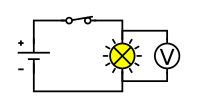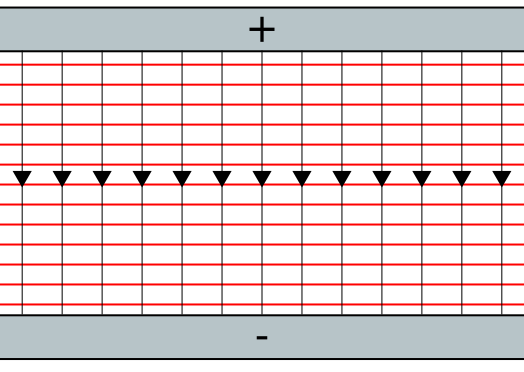OCR Specification focus:
‘Potential difference is energy transferred per unit charge; the volt is its unit.’
Potential difference is a fundamental concept in electricity, describing how electrical energy is converted or transferred between components in a circuit, measured in volts (V).
Understanding Potential Difference
Potential difference (p.d.) represents the amount of energy transferred per unit charge when electric charge moves between two points in a circuit. It indicates how much work the electric field does on charges as they move through components such as resistors, lamps, or motors.
Potential Difference: The energy transferred per unit charge between two points in a circuit.
When a charged particle moves through a component with a potential difference, it either gains or loses energy depending on the direction of the electric field. Components that use electrical energy, such as lamps or resistors, experience a potential drop, while those that supply energy, like cells or batteries, cause a potential rise.
The Volt: The Unit of Potential Difference
The volt (V) is the unit of potential difference, named after the Italian scientist Alessandro Volta. One volt corresponds to one joule of energy transferred per coulomb of charge moved between two points.
EQUATION
—-----------------------------------------------------------------
Definition of the Volt (V) = 1 J C⁻¹
J = joule, unit of energy
C = coulomb, unit of electric charge
—-----------------------------------------------------------------
In simpler terms, if a charge of 1 coulomb transfers 1 joule of energy, the potential difference between the two points is 1 volt.
The volt provides a direct measure of how strongly a circuit component influences the energy of moving charges. A larger potential difference indicates a greater energy change per charge, leading to faster electron flow if resistance remains constant.
Relationship Between Energy, Charge, and Potential Difference
The link between energy, charge, and potential difference is a key principle in circuit analysis.
EQUATION
—-----------------------------------------------------------------
Energy Transfer (W) = V × Q
W = energy transferred (joules, J)
V = potential difference (volts, V)
Q = charge (coulombs, C)
—-----------------------------------------------------------------
This relationship shows that the energy transferred by an electrical component depends on both the potential difference across it and the amount of charge passing through it. If a larger current flows or the potential difference is higher, more energy is transferred.
For example, in a resistor, electrical energy is transformed into heat energy, while in a motor, it is converted into kinetic energy.
Measurement of Potential Difference
To measure potential difference in a circuit, a voltmeter is used. This instrument measures the energy difference per unit charge between two points.
Connection: A voltmeter is always connected in parallel with the component being measured because it must compare two points across that component.

Schematic of a simple circuit with a voltmeter (V) connected in parallel across the load. The diagram emphasises that potential difference is measured between two nodes of the same component. This clean layout mirrors standard circuit-diagram conventions. Source.
Polarity: The positive terminal of the voltmeter is connected to the higher potential point; the negative terminal is connected to the lower potential.
Internal resistance: Ideal voltmeters have an extremely high resistance, ensuring that they draw negligible current and do not alter the circuit’s behaviour.

Two side-by-side schematics compare a voltmeter with very high resistance (negligible circuit effect) against one with comparable resistance (significant loading). The figure demonstrates why voltmeters are designed with large input resistance to preserve the true potential difference. Source.
Voltmeter: A device used to measure potential difference across two points in a circuit, connected in parallel and designed with high internal resistance.
The correct use of a voltmeter is essential for accurate measurement and circuit analysis in both practical and theoretical physics.
Energy Transfer and Circuit Function
Potential difference underpins how energy is distributed within electrical circuits:
Across resistors: Electrical energy is converted into thermal energy due to collisions between electrons and atoms.
Across lamps: Energy is transformed into light and heat.
Across motors: Electrical energy becomes mechanical energy.
Each component thus experiences a potential drop proportional to the energy it transforms. In a closed circuit, the sum of potential rises (provided by power sources) equals the sum of potential drops (across all components). This is an application of the principle of energy conservation in electrical systems.
Potential Difference and Electric Fields
Potential difference is closely related to the concept of an electric field, which represents the force experienced by a unit positive charge.
Electric Field Strength (E): The force per unit charge experienced by a stationary positive test charge.
The potential difference between two points in a uniform electric field depends on the field strength and the distance between the points.

Diagram of a uniform electric field between parallel plates with straight, evenly spaced field lines and perpendicular equipotentials. It visually grounds the relation between field strength, separation, and potential difference discussed in the notes. Source.
EQUATION
—-----------------------------------------------------------------
Potential Difference (V) = E × d
E = electric field strength (volts per metre, V m⁻¹)
d = distance between points (metres, m)
—-----------------------------------------------------------------
This relationship links the microscopic force on individual charges with the macroscopic voltage measured across circuit components.
Distinguishing Potential Difference from Current
While potential difference and current are often mentioned together, they describe different physical quantities.
Potential difference (V) measures energy per charge — how much energy each coulomb of charge transfers.
Current (I) measures charge per second — how much charge flows in one second.
Electric Current: The rate of flow of electric charge through a conductor.
Together, these determine the rate of energy transfer, or power, within the circuit, given by P = V × I. Thus, potential difference influences how effectively electrical energy is converted into other useful forms.
Practical Importance of Potential Difference
Understanding potential difference is vital for designing and analysing electrical circuits. Engineers and physicists use it to:
Ensure that devices receive correct operating voltages.
Analyse energy distribution across multiple components.
Select appropriate power supplies for different applications.
Prevent damage caused by overvoltage or incorrect connections.
In practical physics experiments, careful measurement of potential difference enables accurate calculation of resistance, power, and energy, forming the foundation for deeper study of circuit behaviour and electrical systems.
FAQ
In a series circuit, the total potential difference across the supply is shared between components. The sum of the individual potential differences equals the total supplied voltage.
Each component experiences a potential drop proportional to its resistance. For example, if one resistor has twice the resistance of another, it will have twice the potential difference across it.
This distribution ensures that energy is conserved, as all potential rises from the supply equal the total potential drops across the components.
The cell’s electromotive force (e.m.f.) is the total energy per unit charge supplied by the source, whereas the terminal potential difference is what’s available to the external circuit.
When current flows, some energy is lost within the cell due to its internal resistance. Therefore:
e.m.f. = terminal p.d. + lost volts
This explains why a cell’s measured voltage can drop slightly under load.
Potential difference describes energy transferred per unit charge, not the total energy available. It tells us how efficiently energy is converted between forms as charge moves through a component.
For instance, a 12 V battery doesn’t contain “12 volts of energy” — instead, it provides 12 joules of energy per coulomb of charge passing through the circuit.
This distinction ensures that voltage represents an intensive property, independent of total charge flow.
Electric potential maps use equipotential lines to represent points of equal potential within a field.
Key points:
Lines of equal potential are always perpendicular to electric field lines.
The spacing between equipotentials indicates the field strength: closer lines mean a stronger field.
Moving a charge between equipotentials requires work proportional to the potential difference between them.
This graphical representation helps visualise how energy changes for charges moving in an electric field.
To obtain reliable measurements:
Use a digital voltmeter with high internal resistance to minimise current draw.
Ensure firm, clean connections and avoid long, thin wires that could introduce extra resistance.
Take readings at steady current to avoid fluctuations due to heating effects.
Calibrate the instrument against a known reference voltage if possible.
Good measurement practice ensures that potential difference values accurately reflect the energy changes occurring in the circuit.
Practice Questions
Question 1 (2 marks)
Define potential difference and state its unit.
Mark scheme:
1 mark for stating that potential difference is the energy transferred per unit charge between two points in a circuit.
1 mark for identifying the unit as the volt (V).
Question 2 (5 marks)
A student connects a lamp and a voltmeter in a circuit. The voltmeter reads 6.0 V, and a charge of 4.0 C passes through the lamp.
(a) Calculate the energy transferred by the lamp.
(b) Explain what this potential difference tells you about the energy changes occurring in the lamp.
(c) The student mistakenly connects the voltmeter in series instead of parallel. Explain how this would affect the circuit and the measurement.
Mark scheme:
(a)
1 mark for using the correct equation W = V × Q.
1 mark for correct substitution: W = 6.0 × 4.0 = 24 J.
(b)
1 mark for stating that each coulomb of charge loses 6.0 J of energy as it passes through the lamp.
1 mark for identifying that this energy is converted into light and heat in the lamp.
(c)
1 mark for explaining that connecting the voltmeter in series would increase the total resistance of the circuit.
1 mark for explaining that it would significantly reduce the current and give an incorrect or negligible potential difference reading.

